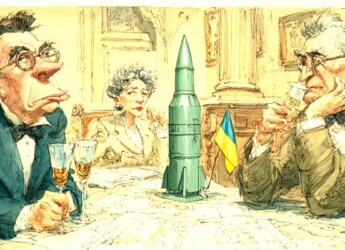|
|
Content Assessment: Beyond the Pause? Ukraine Conflict Assessments in Maps (July 14 - 18, 2022)
Information - 90%
Insight - 88%
Relevance - 91%
Objectivity - 93%
Authority - 94%
91%
Excellent
A short percentage-based assessment of the qualitative benefit of the post highlighting the recent Ukraine conflict assessments in maps from the Institute for the Study of War.
Editor’s Note: One of the most accurate and detailed sources for ongoing updates on the Ukraine crisis is the Ukraine Conflict Update from the Institute for the Study of War. The Institute for the Study of War (ISW) is a 501(c)(3) organization and produces strictly non-partisan, non-ideological, fact-based research. ISW seeks to promote an informed understanding of war and military affairs through comprehensive, independent, and accessible open-source research and analysis. ISW’s research is made available to the general public, military practitioners, policymakers, and media members. Providing a daily synthesis of key events related to the Russian aggression against Ukraine, ISW updates may benefit cybersecurity, information governance, and legal discovery professionals as they follow the business, information technology, and legal trends and trajectories impacted by and stemming from the current Ukraine conflict.
Assessment and Maps*
Ukraine Conflict Assessments – An Overview in Maps
- Institute for the Study of War (ISW), Russia Team
- Critical Threats Project (CTP), American Enterprise Institute
General Assessment Background Info
- ISW systematically publishes Russian campaign assessments that include maps highlighting the assessed control of terrain in Ukraine and main Russian maneuver axes.
- These maps augment daily synthetic products that cover key events related to renewed Russian aggression against Ukraine.
The Russian Offensive Campaign Assessments
- July 18, 2022
- By Karolina Hird, George Barros, Layne Philipson, and Frederick W. Kagan
Key Development
- Russian President Vladimir Putin’s likely effort to put the burden of supporting operations in Ukraine on ethnic minorities to avoid conducting a general mobilization of ethnic Russians may be sparking resistance in ethnic enclaves in Russia.
Key Takeaways:
- The Russian Ministry of Defense’s meeting with the leadership of the Eastern grouping of forces in Ukraine suggests that the Kremlin will not focus on seizing Slovyansk at this stage of the campaign but will instead prioritize attempting to seize Siversk and Bakhmut.
- Russian President Vladimir Putin’s likely effort to put the burden of supporting operations in Ukraine on ethnic minorities to avoid conducting a general mobilization of ethnic Russians may be sparking resistance in ethnic enclaves in Russia.
- Russian forces conducted a series of ground attacks east of Siversk and south of Bakhmut.
- Russian forces intensified efforts to advance on Avdiivka and conducted limited ground assaults along the Donetsk City-Avdiivka frontline.
- Russian authorities are continuing to integrate occupied areas into the Russian trade economy.
- July 17, 2022
- By Karolina Hird, Grace Mappes, George Barros, Layne Philipson, and Frederick W. Kagan
Key Development
- Russian forces are continuing a measured return from the operational pause and conducted limited ground attacks in Donetsk Oblast on July 17.
Key Takeaways
- Russian forces continued a measured return from the operational pause and did not make any confirmed territorial gains on July 17.
- Russian forces continued limited ground assaults around Siversk, Bakhmut, and Donetsk City and otherwise fired at civilian and military infrastructure throughout the Donbas.
- Russian forces focused on defensive operations north of Kharkiv City and along the Southern Axis.
- The Kremlin may be setting long-term conditions for force generation efforts in anticipation of protracted hostilities in Ukraine.
- Russian occupation authorities are likely using the threat of partisan activities to justify harsher societal controls in occupied areas.
- July 16, 2022
- By Karolina Hird, Grace Mappes, George Barros, and Frederick W. Kagan
Key Development
- The Russian Defense Ministry announced that the Russian operational pause has concluded on July 16, confirming ISW’s July 15 assessment.
Key Takeaways
- The Russian Ministry of Defense announced the cessation of the operational pause, confirming ISW’s July 15 assessment that Russian forces are likely resuming ground attacks along multiple axes of advance. The cessation of the operational pause is unlikely to lead to a massive increase in ground attacks across Ukraine but will rather likely be characterized by continued limited ground assaults focused on the Slovyansk-Siversk-Bakhmut salient.
- The Kremlin may have ordered Russian forces to take control of the entirety of Kharkiv Oblast, despite the extraordinary low likelihood of Russian success in such an effort.
- Russian forces conducted limited ground assaults around Siversk and Bakhmut and otherwise fired on Ukrainian military and civilian infrastructure across Eastern Ukraine.
- Russian occupation authorities likely are responding to the perceived threat of Ukrainian partisan activities by strengthening administrative regimes in occupied areas.
- July 15, 2022
- By Kateryna Stepanenko, Grace Mappes, Layne Philipson, George Barros, and Frederick W. Kagan
Key Development
- Russian forces are likely emerging from their operational pause as of July 15. Russian forces carried out a series of limited ground assaults northwest of Slovyansk, southeast of Siversk, along the T1302 Bakhmut-Lysychansk highway, southeast of Bakhmut, and southwest of Donetsk City. These assaults may indicate that Russian forces are attempting to resume their offensive operations in Donbas.
Key Takeaways
- Russian forces are likely emerging from their operational pause, launching ground assaults north of Slovyansk, southeast of Siversk, around Bakhmut, and southwest of Donetsk City.
- Russian forces continued to defend occupied positions in the Kharkiv City direction to prevent Ukrainian forces from advancing toward the Russian border in Kharkiv Oblast.
- Russian forces continued their systematic attacks on civilian infrastructure targeting residential infrastructure, recreational facilities, and educational institutions in Mykolaiv City on July 15.
- Chelyabinsk Oblast officials announced the completion of a volunteer battalion on July 15.
- Russian occupation authorities continued to institute new societal control measures in occupied territories.
- July 14, 2022
- By Kateryna Stepanenko, Layne Philipson, George Barros, and Frederick W. Kagan
Key Development
- The Russian missile strike on Vinnytsia on July 14 was part of a systematic Russian campaign of attacks on residential areas of cities in Ukraine..
Key Takeaways
- Russia continued its campaign of systematic attacks on residential areas in Ukrainian cities with strikes on Vinnytsia, Kharkiv City, and Mykolaiv City.
- Russian forces continued efforts to advance on Siversk but their progress is unclear.
- Russian troops conducted limited ground assaults around Bakhmut and Slovyansk but made no gains.
- Chechen Leader Ramazan Kadyrov claimed that one of the four new battalions he has been forming deployed to Ukraine.
We do not report in detail on Russian war crimes because those activities are well-covered in Western media and do not directly affect the military operations we are assessing and forecasting. We will continue to evaluate and report on the effects of these criminal activities on the Ukrainian military and population and specifically on combat in Ukrainian urban areas. We utterly condemn these Russian violations of the laws of armed conflict, Geneva Conventions, and humanity even though we do not describe them in these reports.
Chronology of Maps from July 14-18 2022 – Mouseover to Scroll
Ukraine Conflict Maps - 071422-071822See the Institute for the Study of War Interactive Map of the Russian Invasion
Read the latest Ukraine Conflict updates from the Institute for the Study of War
* Shared with direct express permission from the Institute for the Study of War (ISW).
About the Institute for the Study of War Research Methodology
ISW’s research methodology relies on both primary and secondary sources, enabling researchers to develop a comprehensive understanding of the situation on the ground. In order to analyze military and political developments in any given area, ISW’s research analysts must wholly understand the systems of enemy and friendly forces. They must also understand the population demographics, physical terrain, politics, and history of that area. This lays the analytical foundation for understanding the reasons for particular developments and fulfilling their assigned research objectives. ISW analysts also spend time in places like Iraq, Afghanistan, and elsewhere in order to gain a better understanding of the security and political situation and to evaluate the implementation of current strategies and policies. Our researchers compile data and analyze trends, producing a granular analysis of developments in areas of research, producing an accurate, high-resolution, timely, and thorough picture of the situation. ISW’s research methodology guarantees its success and commitment to improving the nation’s ability to execute military operations, achieve strategic objectives, and respond to emerging problems that may require the use of American military power.
About the Institute for the Study of War
The Institute for the Study of War advances an informed understanding of military affairs through reliable research, trusted analysis, and innovative education. We are committed to improving the nation’s ability to execute military operations and respond to emerging threats in order to achieve U.S. strategic objectives. ISW is a non-partisan, non-profit, public policy research organization.
Learn more, get involved, and contribute today.
Additional Reading
- [Annual Update] International Cyber Law in Practice: Interactive Toolkit
- Data Embassies: Sovereignty, Security, and Continuity for Nation-States
Source: ComplexDiscovery


























